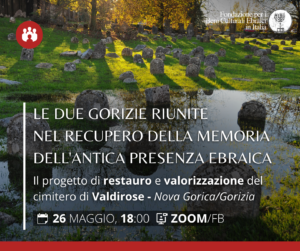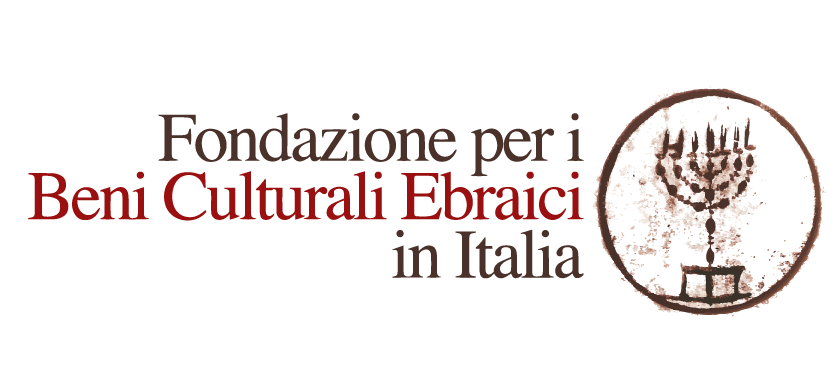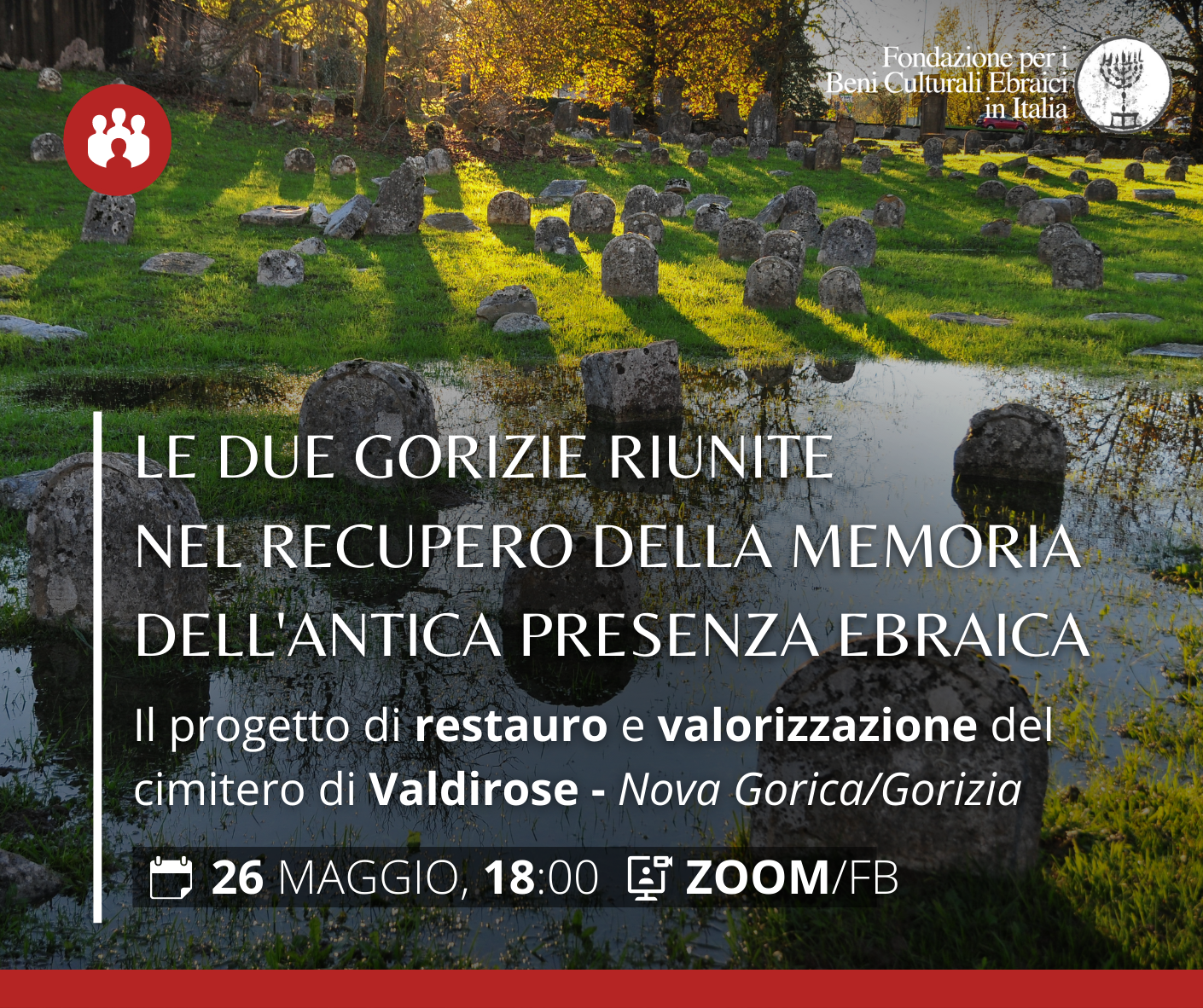
THE TWO GORIZIAS PROMOTE A PROJECT TO RECOVER
THE MEMORY OF THE ANCIENT JEWISH PRESENCE
Restoration Project for the Ancient Jewish Cemetery of Valdirose – Nova Gorica/Gorizia
click here for the program (ITA)
PROGRAMME
Authorities & Institutional Welcome
Dario Disegni – President of the Foundation for Jewish Cultural Heritage in Italy (FBCEI)
Damjana Pavlica – Deputy Mayor of Nova Gorica
Rodolfo Ziberna – Mayor of Gorizia
Livio Vasieri – Councillor of the Trieste Jewish Community
Andrea Zannini – DIUM (Department of Humanities and Cultural Heritage) University of Udine
A representative of Beneficentia Stiftung
Historical Background
Maddalena Del Bianco – Full Professor of History of Religions, University of Udine
– Jerusalem on the Isonzo River: a History of Jews in the District of Gorizia
Renato Podbersič – Historian, University of Nova Gorica
– The History of the Jewish Cemetery of Valdirose
Project
Andrea Morpurgo – Project Manager and FBCEI Councillor
– Restoration and Promotion of the Valdirose Jewish Cemetery
Renzo Funaro – FBCEI Vice President
– The Project: Restoration Methods
European Capitals of Culture
Paolo Verri – Cultural Manager, former Director General of the Matera Basilicata 2019 Foundation
– Heritage and Innovation: a Capital Challenge? The Case of Matera 2019
Lorenzo De Sabbata – ISIG researcher and GO! 2025 application coordinator
– Nova Gorica and Gorizia: the Road Leading to Europe
Chair
Giorgio Segré Member of the FBCEI Board
________________________________________
The Foundation for Jewish Cultural Heritage in Italy (FBCEI- Fondazione per i Beni Culturali Ebraici in Italia) was established by the Union of Italian Jewish Communities (UCEI- Unione delle Comunità Ebraiche italiane) in 1986, with the aim of restoring, conserving, refurbishing and promoting the Italian Jewish historical and artistic heritage and disseminate the relevant information in Italy and abroad. FBCEI aims to be a point of reference and support for Italian Jewish Communities, and in particular for the smaller ones, in developing their activities.
FBCEI also develops projects in areas where there is no longer a Jewish community with the aim of protecting, conserving and enhancing cultural heritage where possible, in particular, of places of worship, ghettos, buildings and cemeteries and any other artistic or bibliographic heritage, so that this memory may become an added value.
The memory of the Jewish presence is a key part of an identity, a tessera in a mosaic of other memories, that is the historical wealth and identity of a given territory.
The protection and promotion of cultural heritage also sees the Foundation focussing on its ability to generate economic value through tourism and cultural value through the dissemination of knowledge.
In this context, the project for the restoration and promotion of the Gorizia Jewish community cemetery, located on the Slovenian side, Valdirose (Nova Gorica) a few metres from the border, is both important and specific to the area. This is what informs a second appointment of the 2021 cycle of online seminars devoted to this project, developing a complex discussion with many of the parties to it that are working for its success.
The cemetery is almost unique in terms of its cross-border location and for the memories it preserves, which is one of the project’s specific merits. It highlights the complex Jewish Community of Gorizia which had welcomed the many facets of a community without borders merging them in the name of a shared religious, historical and cultural identity. In fact, Joseph II’s eighteenth-century Edict of Toleration (Toleranzpatent) had granted a degree of freedom to his subjects of Jewish religion within the Habsburg Empire. Subsequently, the French occupation pulled down the ghetto gates, and in the Nineteenth century many Jews from various parts of the vast Austro-Hungarian Empire, converged to Gorizia from the peninsula and also from the Dalmatian areas, through the free port of Trieste. Their many identities are now symbolically enshrined in the gravestones of the Valdirose cemetery, now sadly crumbling.
Gorizia/Nova Gorica was a borderland, land of bitter battles in the First World War: the joint bid of the two cities as European Capital of Culture 2025, further promotes the territory and the revival of the places that hold the memory of the Jewish Community of Gorizia.
The seminar will be attended by Dario Disegni, FBCEI President, Rodolfo Ziberna, the Mayor of Gorizia, with a video message, Damjana Paulica, the Deputy Mayor of Nova Gorica, Livio Vasieri, Councillor for Cultural Heritage of the Jewish Community of Trieste as Gorizia has become a Section of Trieste’s Community, Professor Andrea Zannini, Director of the History Department of the University of Udine, Chair of Modern History and a representative of the Beneficentia Stiftung Foundation, followed by the speakers.
Historical background
The Seminar on May the 26th, 2021 is consistent with the philosophy of the project starting with the contributions by two historians: Maddalena Del Bianco, Professor of History of Religions and History of Judaism at the University of Udine whose presentation will focus on the history of Jews in Gorizia and Prof. Renato Podbersic’ of the University of Nova Gorica who will illustrate the history of the Jewish cemetery of Valdirose.
The origins of Gorica and the first Jewish settlement in the city have not yet been fully uncovered: Gorizia is said to mean ‘a small hill suitable for the construction of a high and easily defended fortress’, and the first certain information dates back to 1001 ME, when Otto III assigned part of the Salcano Castle and of the villa called ‘Goritia’ to John, Patriarch of Aquileia, and the other part to Werihen, Count of Friuli. The presence of an albeit limited Jewish settlement in the area dates back to the end of the 13th century although the first documents attesting to the community’s settled presence date from the 14th century. During the 16th century the first serious persecutions of the Isonzo Jews began. In 1534, Emperor Ferdinand I, ‘concerning the complaints of his provinces about the usury they were committing, declared with a sovereign resolution that they should generally be excluded from all his states within six months’ and even the pleas of the government of Gorizia in favour of some of them proved fruitless. In spite of the expulsion edict reissued by Archduke Charles in 1565, some Jewish families somehow managed to stay or return to Gorizia.
Money lending at an interest was defined as ‘usury’, even if the interest was not very high and was then the main activity for the Gorizia Jews. In fact it was almost inevitably a Jewish activity since this economic activity was forbidden to Christians by the Church. As a result, many Jews were owners of loan (or usury) banks and their management presumed the stipulation of a ten-year agreement with the local authorities. More post 17th century documents are available: in 1624, Emperor Ferdinand II granted the title of Hofjuden, i.e. Court Jew, to Joseph Pincherle of Gorizia and other prominent Jews from Gradisca and Trieste and their relatives. This was important because one of the privileges that these Jewish families enjoyed was the certainty that they would not be banned from imperial territory; moreover, they could circulate without the having to wear the identification badge and could own real estate. We also have more notary deeds from that century, attesting to the presence of a number of Jewish families in the Counties and providing evidence of their living conditions.
However, the situation changed in the 18th century: by 1698 a ghetto had already been established in the district of San Giovanni in Gorizia, eleven houses, all owned by Christians and rented to Jewish heads of families. Inside the ghetto the Jews carried out business, specifically silk and wax, money lending and trade. In 1767 Jews were forbidden to own pawnshops. Not long before, in 1753, the first pawnshop had been established in Gorizia at the behest of Archbishop Carlo Michele d’Attems, who also provided the initial capital. However, after his death the institute declined and was only reopened in 1790 with an increased interest rate (from 6% to 8%).
Towards the end of the 18th century, conditions for the Jewish community improved, with Emperor Joseph II issuing a rescript on May 16th, 1781, addressed to the highest authorities of the provinces of the Empire, pursuant to which the Jews were able to enjoy considerable concessions such as attending universities and exercising a trade of choice. Between 1797 and 1813 the French invaded Gorizia and the coast three times: for the first time Jews were allowed to hold public office and the mandatory residence in the ghetto was abolished. With the return of the Habsburgs, the Edicts of Tolerance were confirmed and the Jews were allowed to reside outside the ghetto. Around the mid-19th century Jews living in the Empire were given the same status as other citizens, although they were excluded from public offices.
In 1880 the ghetto district was named after the Gorizian glottologist Graziadio Isaia Ascoli, who was born at no. 1 of the street that bears his name. The Jewish community of Gorizia left many signs of its presence, giving the city famous figures, such as Rabbi Isaac Samuel Reggio, the philosopher Carlo Michelstaedter, and the journalist Carolina Sabbadini Coen Luzzatto, whose tombstone is in the Valdirose cemetery. In the years of the First World War, young Jews from Gorizia and other parts of Italy gave their lives fighting in these areas where the front line passed, right near the Valdirose cemetery.
Between 1943 and 1944, the thriving Jewish community was practically wiped out by the Nazi deportations and extermination in the concentration camps. In spite of this, the synagogue, built in 1756 underwent major restoration works after the war and is currently one of the most important tourist/cultural destinations of the city. The former synagogue is now seat of the ‘Museum of Jerusalem on the Isonzo’, dedicated to the history of the Jewish people and of Gorizia’s Jews, and the ancient ghetto, located along Via Ascoli.
The subject of our project, that is the ancient cemetery of Valdirose, bears witness to the Jewish presence in Gorizia. The cemetery has about 900 tombs, with valuable gravestones, the oldest of which dates back to 1371. Although the boundary wall, the former mortuary and some graves of famous people have been restored, the cemetery is currently in a state of ruin and many gravestones are illegible, broken or fallen or remain buried under the surface.
The Project
A presentation by Andrea Morpurgo, Project Manager and FBCEI Director will focus on the restoration and promotion project for the Valdirose Jewish Cemetery, followed by Renzo Funaro, FBCEI Vice-President who will illustrate the methods used the restoration of the cemetery to be implemented with the most advanced technical systems of detection, cataloguing and conservation.
The various phases of the project can be briefly outlined as follows
Preliminary phase – General (Topographic) survey (in progress)
In the absence of computerised mapping instruments, a basic topographical survey is required to for a correct morphological, orographic and altimetric definition of the area under study, as well as the position of the tombstones in the site under study and intervention.
The Infopoint Project: learning about the Jewish cemetery of Valdirose
On the first floor of the former funeral tempietto, the project envisages an exhibition and information space (panels + computerised media) on the history of the Jewish cemetery, its community and the famous people buried there. Further additional complementary initiatives are also planned.
The Restoration and Promotion of the Jewish Community Cemetery of Gorizia
– State of the site
A field with 400 gravestones in an area of 4,684 square metres. Figures correspond to roughly about half of the area considering that the 1976 census listed 692 tombstones. This means one can reasonably expect at least a further 300 broken and fallen tombstones are buried in the grassy soil.
Historical Research
Archival research will include indirect sources on the history of the site, from its establishment and/or foundation to the present day.
A historical-architectural report will be drafted when the work is finished.
A computerised Data Mapping
The aim is to set up a computerised map inputting the data on the surveyed and registered tombstones in the relevant digital maps, thus linking the alphanumeric, graphic and photographic data with the topographical ones.
Nova Gorica/Gorizia: European Capital of Culture 2025
The last contribution will analyse the prospects of this important cross-border project, in the context of Nova Gorica and Gorizia as European Capital of Culture 2025. In the Foundation’s opinion, the project could become an added value one of the strategic key elements, a virtuous circle improving the well-being of the territory and its community. However, this approach requires implementing the existing synergy between the Foundation and the various institutional and private points of reference. It will also be essential to identify the European, as well as national and regional public and private funding channels required to successfully complete the project.
Paolo Verri, Cultural Manager, former GM of the Matera Basilicata 2019 Foundation, will introduce a new perspective aimed at the younger generations on the basis of his experience in re-launching Matera from a cultural, tourist and economic point of view. His approach will focus above all on the socio-economic profiles that have a positive impact on such initiatives. He will be followed by Lorenzo De Sabbata, ISIG researcher and Coordinator of GO! 2025, Committee for Nova Gorica/Gorizia European Capital of Culture 2025.
In conclusion, the project intends to build a bridge between the past and the future and the Foundation is taking a synergic approach with a variety of institutional, private, economic and cultural players that are essential for its success.
The Municipality of Gorizia, the Municipality of Nova Gorica, the Community of Trieste , the University of Udine, Beneficientia, a charitable Liechtenstein foundation, which has generously funded FBCEI in getting the project off the ground, and the GO! 2025 Committee are the first institutions and associations to have joined this stimulating and challenging adventure.
We are looking forward to a lively discussion with the above speakers, technical experts and historians in the Zoom seminar on Wednesday 26 May 2021, at 6 pm.





